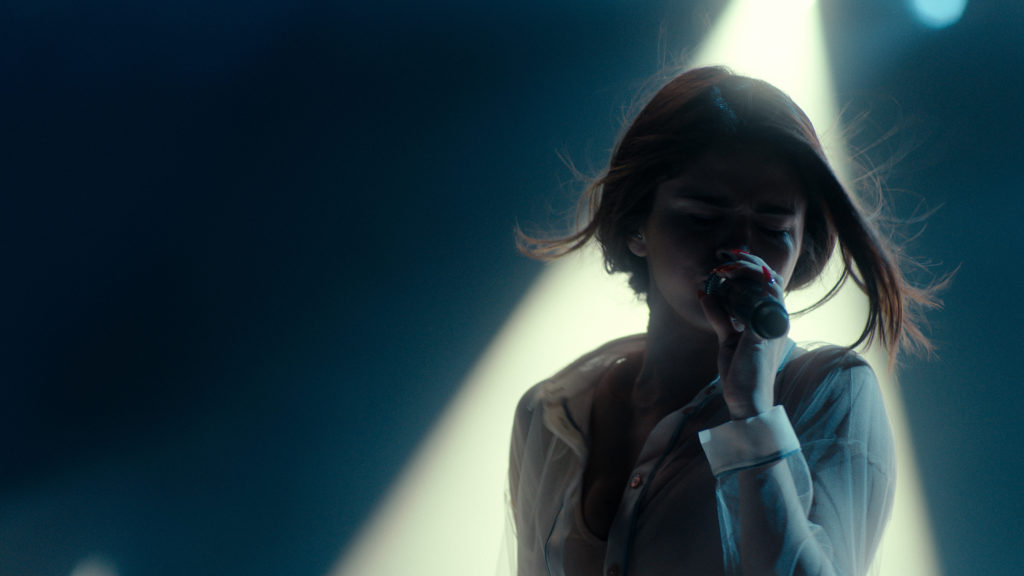
Life between the headphones is a sacred space. Intimate and personal; transformative and powerful. Lyrical stories pass directly to listeners as emotions seep through the headphones, speakers, or AirPods. As a musician, Selena Gomez knows this power. And the sound team of her documentary, “Selena Gomez: My Mind and Me” knows it too.
Within the opening moments of “My Mind and Me,” as the story jumps from hotel rooms to the backseats of limos, to concrete parking garages under arenas, the ears and eyes are eventually treated to Selena’s personal journal entries. Her voice is accompanied by rain. And then, the storm is violently interrupted with a different auditory storm: the onslaught of paparazzi, frenzied shutters enhanced and heightened with additional semi-hidden sounds of bullets and punches, bursting the audience into a uneasy feeling, “the way that Selena is feeling in those scenes,” shares Anthony Vanchure, Supervising Sound Editor of “Selena Gomez: My Mind and Me.”
While archival footage and unprecedented access to Selena’s life create the visual narrative, along with abstract re-creations, “My Mind and Me” truly travels through its ever-shifting journey from the intense to the intimate and back again with deliberate sound design. In this non-fiction space, the film’s moments are enhanced and the story is truly delivered through sound design.
“A lot of people don’t realize how much sound design can go into a documentary…and how many cinematic moments you can enhance and even create using sound,” shared Sound Designer Mike James Gallagher. Gallagher was part of a team assembled by Supervising Sound Editor Vanchure to achieve director Alek Keshishian’s creative goals when it came to sound. Specifically, as a sound designer, Gallagher makes the choices around sound effects, layers, and edits. “In the way that a cinematographer is visually responsible for all the creative things [with] lighting, [a] sound designer is responsible for every audio decision that’s being made,” Gallagher explained.
As the Supervising Sound Editor, Anthony Vanchure leads the conversations with the film director and creates a team tasked with bringing the director’s goals to life. “ I’m in constant communications with the director talking about what they want from each scene, what they’re looking for, specifically, from sound to help tell their stories,” Vanchure described about his role. The sound team then dives into particular questions, such as “What do we want to bring to the table? What are we looking to do? What kind of sounds do we want to tell? Or make and show and help tell the story?” Vanchure explained.
As “My Mind and Me” oscillates through the intimate to the intense, the sound team was truly given the opportunity to play. The film’s personal, vulnerable moments with Gomez’s diary on full display were not achieved through ADR in a booth. “The voice over, it’s her in her house doing these, re-feeling those emotions so it’s a little bit more personal than ADR would be,” Vanchure explained. These one liners and striking diary moments are accompanied with rain. But of course, in sound design, it’s never just rain. “I want to really take that idea and expand on it and make sure that I’m building a very, very wide palette of rain-like sounds, making sure that it moves and weaves and all that kind of fun stuff,” expanded Gallagher. “When someone says rain, you really want a wide palette of rain. So you want close up recordings, you want wide recordings, you want stereo recordings, just like all different kinds of aspects and perspectives of rain to play with…You kind of have to keep this feeling of, you know, going in and out of different perspectives.”
To achieve their sound goals during the intense moments of the film, such as the aforementioned onslaught of paparazzi, the team pulled from both a library of sounds and recorded a loop group. “We did have to help create and make those moments sound bigger,” Vanchure explained. Imagine: being hired to perform as paparazzi, on an ADR stage, screaming Selena, while microphones capture the sound. Then, additional elements can be added to “really reinforce that feeling of chaos, unease, and panic,” Gallagher explained. Bullets. Punches.
The elements can truly add up. It is not uncommon for Gallagher to have 40 tracks or more in use at one time during an effects scene, of course, knowing that sounds come in and out, back and forth, much like the story of “My Mind of Me” as it shifts from the intimate and personal and back out again. “It’s a very cinematic thing, to go from intimate, close, dry, to moments [that are] more dense and abstract,” Gallagher added.
Those close moments may feel different to viewers depending on their medium of choice whether be Apple TV, Apple AirPods, or a theatrical viewing experience. “You’re mixing and you’re going okay, this might play differently on an iPad or a TV or somebody’s speakers,” explains Vanchure. “How do we translate for those moments?” Translation, notes, and interpretations seem to be at play in this piece. Whether it’s speakers, or headphones where that sacred space plays out, the environment provides a mesmerizing playground for sound and story, even in the nonfiction world. There’s an art of racing in the rain. Singing in the rain. Dancing in the rain. And as Selena learned to dance through her own personal storm, the sound team helped provide the enhancement for that story, playing with documentary sound.
